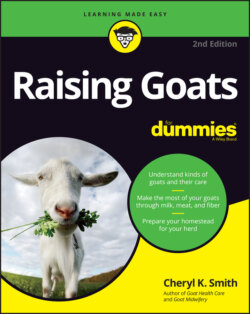Читать книгу Raising Goats For Dummies - Cheryl K. Smith - Страница 97
Making trees goat-proof
ОглавлениеGoats will damage and eventually kill trees by browsing on the leaves and shoots, stripping the bark, and rubbing their horns (if they have them) on the trees. The only trees I have that seem to be immune to goat damage are old-growth Douglas firs whose bark is probably not tender enough for them. Your goats cause worse damage when they don’t have access to any other plants to eat, but they enjoy tender bark and leaves even when grass and shrubs are available.
If you want to save trees that are within the goats’ fenced area or just outside the fence, you need to goat-proof them. A better choice, if you can manage it, is to avoid including trees in the goats’ area; goat-proofing individual trees is time-consuming and expensive.
For smaller trees or saplings, you can buy 5-foot-tall tree bark protectors from garden stores or wholesalers. These mesh or corrugated plastic tubes were designed to fit around the tree trunks to protect them from deer.
You can goat-proof a larger tree simply by wrapping it up to the level that your largest goat can reach when standing with its front legs on the tree. You can determine this height by holding a treat up next to the tree and measuring how high the goat can reach. (If your goats aren’t full-grown, you have to estimate.)
One downside to goat-proofing is that it can inhibit growth of the tree, so you need to check the tree to see whether the wrapping is too tight and rewrap it every few years.
Materials you can use to wrap a tree include
Plastic strips designed to cover rain gutters to keep leaves out: I found these at a garage sale. I wrapped them around the tree and hooked them together with wire.
Hardware cloth, also called rabbit wire: It is more rigid than gutter covers and can be attached to the tree or to posts in the ground surrounding the tree. However, it’s expensive and doesn’t fit as neatly as gutter covers. If you attach hardware cloth directly to the tree, it also will inhibit outward growth.
Window screen netting: You can obtain a 1,000-foot roll for less than $100 and use it to wrap quite a few trees, depending on their diameter.
If you have only a few trees at risk of being debarked and want something more permanent, you can goat-proof trees with triangular wooden enclosures like those in Figure 4-1. A wooden enclosure requires three posts as tall as the tallest goat can reach, and wooden slats attached with screws across them. You can attach them close enough together to prevent the goats from getting their heads through the slats, or you can make the enclosure far enough outside the tree that they can’t reach even if they get their heads through.
FIGURE 4-1: A tree goat-proofed with a wooden enclosure.
